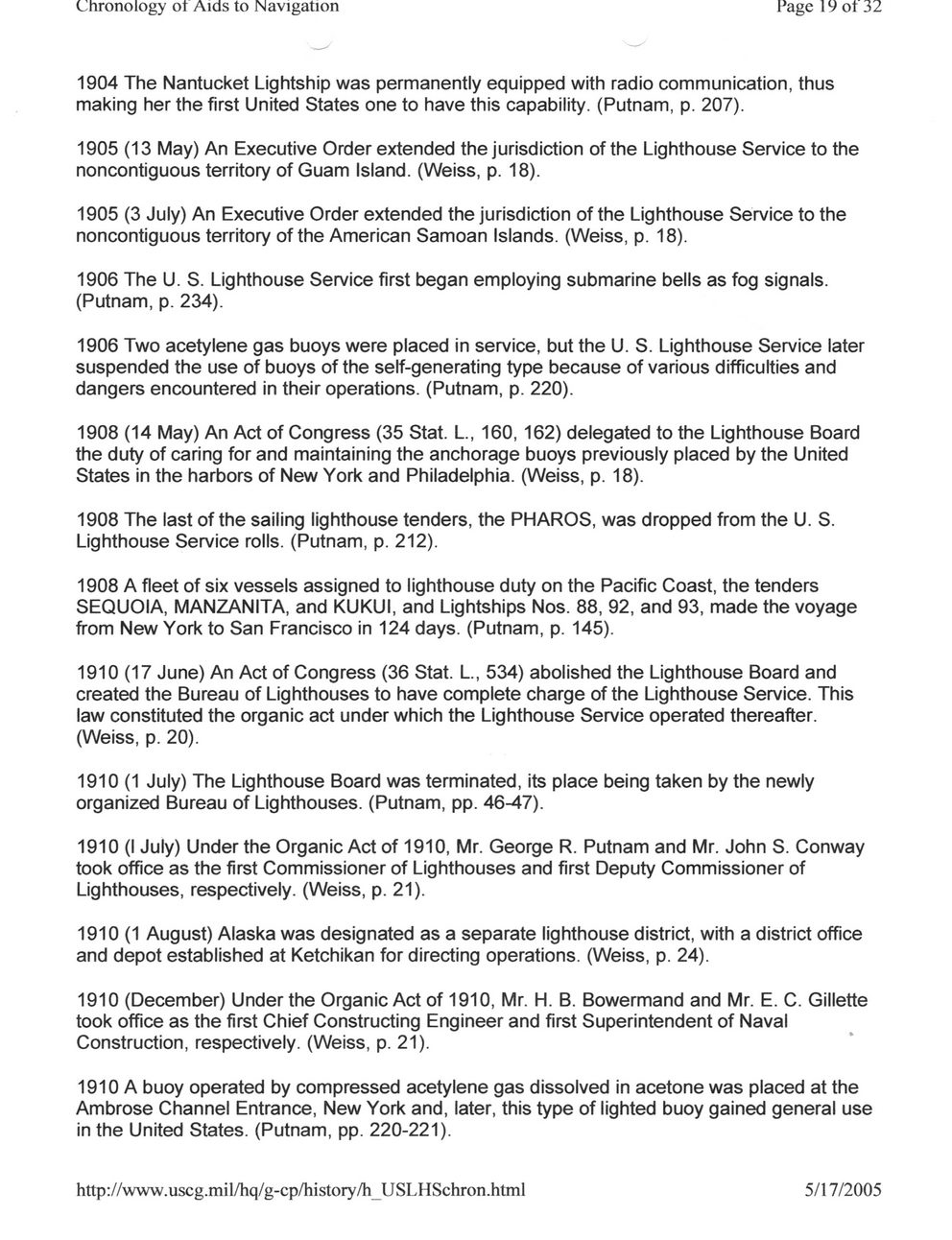This text was obtained via automated optical character recognition.
It has not been edited and may therefore contain several errors.
Chronology or Aids to Navigation Page 19 of 32 1904 The Nantucket Lightship was permanently equipped with radio communication, thus making her the first United States one to have this capability. (Putnam, p. 207). 1905 (13 May) An Executive Order extended the jurisdiction of the Lighthouse Service to the noncontiguous territory of Guam Island. (Weiss, p. 18). 1905 (3 July) An Executive Order extended the jurisdiction of the Lighthouse Service to the noncontiguous territory of the American Samoan Islands. (Weiss, p. 18). 1906 The U. S. Lighthouse Service first began employing submarine bells as fog signals. (Putnam, p. 234). 1906 Two acetylene gas buoys were placed in service, but the U. S. Lighthouse Service later suspended the use of buoys of the self-generating type because of various difficulties and dangers encountered in their operations. (Putnam, p. 220). 1908 (14 May) An Act of Congress (35 Stat. L., 160, 162) delegated to the Lighthouse Board the duty of caring for and maintaining the anchorage buoys previously placed by the United States in the harbors of New York and Philadelphia. (Weiss, p. 18). 1908 The last of the sailing lighthouse tenders, the PHAROS, was dropped from the U. S. Lighthouse Service rolls. (Putnam, p. 212). 1908 A fleet of six vessels assigned to lighthouse duty on the Pacific Coast, the tenders SEQUOIA, MANZANITA, and KUKUI, and Lightships Nos. 88, 92, and 93, made the voyage from New York to San Francisco in 124 days. (Putnam, p. 145). 1910 (17 June) An Act of Congress (36 Stat. L., 534) abolished the Lighthouse Board and created the Bureau of Lighthouses to have complete charge of the Lighthouse Service. This law constituted the organic act under which the Lighthouse Service operated thereafter. (Weiss, p. 20). 1910 (1 July) The Lighthouse Board was terminated, its place being taken by the newly organized Bureau of Lighthouses. (Putnam, pp. 46-47). 1910 (I July) Under the Organic Act of 1910, Mr. George R. Putnam and Mr. John S. Conway took office as the first Commissioner of Lighthouses and first Deputy Commissioner of Lighthouses, respectively. (Weiss, p. 21). 1910 (1 August) Alaska was designated as a separate lighthouse district, with a district office and depot established at Ketchikan for directing operations. (Weiss, p. 24). 1910 (December) Under the Organic Act of 1910, Mr. H. B. Bowermand and Mr. E. C. Gillette took office as the first Chief Constructing Engineer and first Superintendent of Naval Construction, respectively. (Weiss, p. 21). 1910 A buoy operated by compressed acetylene gas dissolved in acetone was placed at the Ambrose Channel Entrance, New York and, later, this type of lighted buoy gained general use in the United States. (Putnam, pp. 220-221). http://www.uscg.mil/hq/g-cp/history/h_USLHSchron.html 5/17/2005

Lighthouses Chronology-of-Aids-to-Navigation-(19)